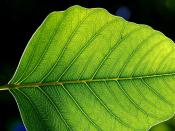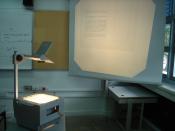BACKGROUND:
Photosynthesis is the process in which light energy is converted to the chemical energy of sugars. It can be summarised in the following equation.
Cardon dioxide + Water in the presence of chlorophyll and light produces Glucose + Oxygen
This process occurs in the chloroplasts of plant cells which are primarily found in the leaves.
To measure the rate of photosynthesis in this practical you are going to measure the time it takes for leaf disks to rise to the surface of water in a beaker.
When disks are cut from fresh leaves and kept moist, the cells of the leaf remain alive and are capable of carrying out photosynthesis. Normally these leaves would float in a beaker of water but when the air is removed from the spongy mesophyll air spaces by creating a low pressure they will sink because they become less dense than the solution.
In the presence of light the cells in the leaf photosynthesise to produce oxygen which makes them more buoyant until eventually they float to the surface.
The quicker the disks rise, the faster the rate of photosynthesis has occurred.
AIM:
To measure the effect of carbon dioxide concentration on the rate of photosynthesis in leaf disks.
MATERIALS REQUIRED:
Fresh green leaves (eg. Ivy)
Cork borer or hole punch (approx. 8mm)
Solutions of sodium hydrogen carbonate (2%,4%,6%,8%,10%)
Overhead projector
6 x 25mL Beakers
Sieve
Forceps
Buchner flask and Vacuum pump or a 50 mL plastic syringe
50 mL measuring cylinders
Distilled water
Stop watch
METHOD:
Read through the whole procedure before you begin to allow for the careful planning that is necessary. It will help to work in groups of 4 for this experiment.
Beaker Concentration of Hydrogen Carbonate solution
A 0% (Distilled water) B 2% C 4% D 6% E 8%...

![Global Photosynthesis Visualized [video]](https://s.writework.com/uploads/5/59070/global-photosynthesis-visualized-video-thumb.jpg)
